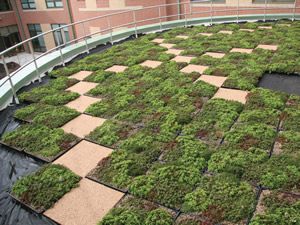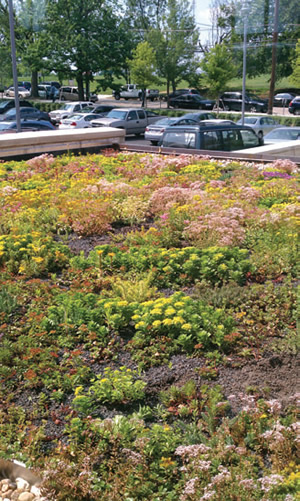School Roofs Aren't What They Used To Be
- By Michael Fickes
- 03/01/14

PHOTOS COURTESY OF FANNING HOWEY
They really don't make roofs the way they used to. What a relief. Why didn’t someone think of this before? Today’s new roofs are increasingly sustainable and teachable, with solar arrays, roof gardens and white membrane. Many districts have policies that are pushing sustainable roofs for schools.
In Washington, D.C., the District of Columbia Public School’s “Smart Roof” program may become one of the most comprehensive sustainable roof programs in the country. “The Department of General Services (DGS), which oversees school construction, is rolling out this program now,” says Ed Schmidt, AIA, executive Director of the Washington, D.C., office of Fanning Howey, a national K-12 school planning and design firm.
As a first step, DGS evaluated the roofs on all city schools, continues Schmidt. They looked for opportunities ranging from solar energy production of electricity with photovoltaic panels and solar thermal hot water heating to daylighting with skylights, green roofs and blue roofs. (See accompanying story, page 30.)
The evaluations included the school’s academic offerings, physical feasibility and a cost benefit analysis designed to identify the best sustainable options for each roof.
“For instance, Phelps High School is an architecture, construction and engineering high school,” Schmidt says. “Because of the academic program, the school has cisterns to collect rainwater and photovoltaic arrays on the roof. It’s designed in a way that makes the roof into a classroom area. The students can go to the roof and study how the collectors are angled, how they operate and how they are maintained.”
The school also uses solar thermal panels to supply the kitchen and restrooms with hot water.
“So it is more than a sustainable roof; the roof can become a component of the educational program,” adds Schmidt.
 While some schools already have solar roofs and green roofs, the “Smart Roof” program will roll out in earnest this year. “In 2014, we plan to install several hundred thousand feet of cool roof restoration — from black roofs to white roofs,” says Beth Penfield, LEED-AP, REFP, senior project manager with Brailsford & Dunlavey, Inc., the program manager for the District of Columbia Public Schools building program.
While some schools already have solar roofs and green roofs, the “Smart Roof” program will roll out in earnest this year. “In 2014, we plan to install several hundred thousand feet of cool roof restoration — from black roofs to white roofs,” says Beth Penfield, LEED-AP, REFP, senior project manager with Brailsford & Dunlavey, Inc., the program manager for the District of Columbia Public Schools building program.
“This year’s program will also build at least five more green roofs and two solar thermal roofs. Notably, as a result of the smart roof project and analysis, the Department of General Services will begin rooftop solar installations at a truly extraordinary scale in 2014. We anticipate equipping more than three-dozen roofs and acquiring an overall new generating capacity of 10 MW (mega watts.) This will be the largest single property-owner solar deployment in any U.S. city ever.”
Most of the district’s newest schools were designed with sustainable roofs. Technically, there aren’t a lot of new schools in the District of Columbia, but there are very old schools that have undergone such comprehensive renovations that they seem new.
At the 75-year-old Woodrow Wilson High School, for instance, a massive renovation transformed an aging school into a modern model of academics and sustainability. The roof features a 7,000-square-foot green roof and solar panels that generate electricity for the school’s aquatic center.
The district’s major renovation of Dunbar High School features another approach to solar roofs. There, DGS negotiated a 20-year power purchase agreement with Constellation Energy Resources, LLC. Under this agreement, Constellation financed, owns and operates a solar power array on Dunbar’s roof.
According to DGS, the array consists of 1,940 solar photovoltaic panels and will generate approximately 543,287 kwh hours of electricity per year, about 20 percent of Dunbar’s electricity requirements. DGS purchases the electricity from Constellation at rates below the cost of electricity purchased from the grid.
“Another advantage to the power purchase agreement involves the school district’s capital budget,” adds Schmidt. “Since Constellation owns the system and sells the power to the school, the capital cost of the system doesn’t count towards the school district’s debt cap.
While the District of Columbia’s “Smart Roof” program is probably unique, other school districts, large and small, are moving toward sustainable roofs.
New York City’s rooftop schools
 Like Phelps High School in the District of Columbia, New York City Public Schools have taken an interest in green roofs for their environmental and educational benefits.
Like Phelps High School in the District of Columbia, New York City Public Schools have taken an interest in green roofs for their environmental and educational benefits.
In fact, three New York City schools are collaborating on a guide to using green roofs in the curriculum. PS41, a K-5 school in Manhattan, is the lead school in the project, thanks to its 15,000-square-foot Greenroof Environmental Literacy Laboratory (GELL), which has been managing storm water and functioning as a classroom for two years now.
Vicki Sando, a PS41 science teacher, is spearheading the effort. Lessons on her green roof include the affect of different soils on plant growth and why different plants attract particular species of insects. Remember these students are big city kids from Manhattan. They may read about these kinds of things, but only a green roof can enable them to witness the action.
While the curriculum guide covers green roofs, Sando also uses the roof’s solar panel system and wind turbine to illustrate lessons about renewable energy.
The curriculum guide will also include lessons growing crops, environmental research and sustainable practices such as rainwater harvesting and photovoltaic arrays.
Three green roofs in Lancaster, Pa.
Smaller school districts are getting in on the sustainable roof trend. Three School District of Lancaster (SDL) schools have green roofs.
The state Department of Environmental Protection offered a grant of $479,000 to fund the construction of the roofs.
SDL received $118,710 in grant money, which funded 10,000-square-foot roof gardens at Lafayette Elementary School and Thomas Wharton Elementary School in Lancaster.
The district applied successful for another grant from the Lancaster Foundation for Educational Excellence and received $30,000, which funded a 2,200-square-foot green roof for George Ross Elementary School.
Practical matters
The economic benefits of sustainable roofs include lower utility costs. How much lower depends upon the size of the installation and the amount of electricity produced.
Unhappily, green roofs and solar roofs take quite a while to pay for themselves. Estimates vary but generally speaking, the range seems to be around 10 to 20 years.
Subsidies in the form of grants, rebates and tax incentives — all available today — can speed the payback period.
As with all technologies, increasing demand eventually drives prices down and in the case of solar and green roofs will lower the payback period.
By comparison, cool white roofs cost less and pay for themselves in one to five years. Payback is faster in warmer climates.
While costs and payback schedules may discourage commercial users today, adding the educational and environmental benefits of sustainable roofs to the mix can help to make the case for sustainable K-12 school building roofs.
Up On The Rooftop
What are all these things schools are putting on the roof these days? They include two kinds of solar equipment, water collection equipment and plumbing to drain store and use collected water, green or vegetative roofs and cool roofs.
Solar arrays are composed of photovoltaic panels that collect sunlight and generate electricity. The installation includes an electrical transmission system to take power into the building and connect it to systems. Benefits include lower electricity costs and reduced fossil fuel use.
Solar thermal panels are flat roof panels with tubes of circulating liquid inside. The sun heats the panels, which in turn heat the circulating liquid, which flows to the water heater, heats the water and returns to the roof panel to be reheated. Benefits are similar to those produced by solar arrays.
Blue roofs collect storm water and prevent storm water runoff, a huge issue in the District of Columbia. Blue roof systems also use the water to irrigate green roofs and landscaping around the building as well as to flush toilets in the school. Blue roofs can also control the rate of storm water runoff . Benefits include lower costs for water plus better management of discharged water.
Green roofs are systems that consist of seven components. The components include a structural system, waterproof membrane, root repellant system, drainage system, filter system, a growing medium and the vegetation. Benefits include storm water management including storm water reduction — some of the water evaporates, and vegetation consumes some of it. Green roofs also reduce the heat sink effects, caused by black roofs absorbing heat from the sun. Green roofs provide insulation against heat and cold.
Cool roofs are white roofing membranes. Like green roofs, cool roofs reflect heat and reduce heat-sinking effects.
This article originally appeared in the issue of .